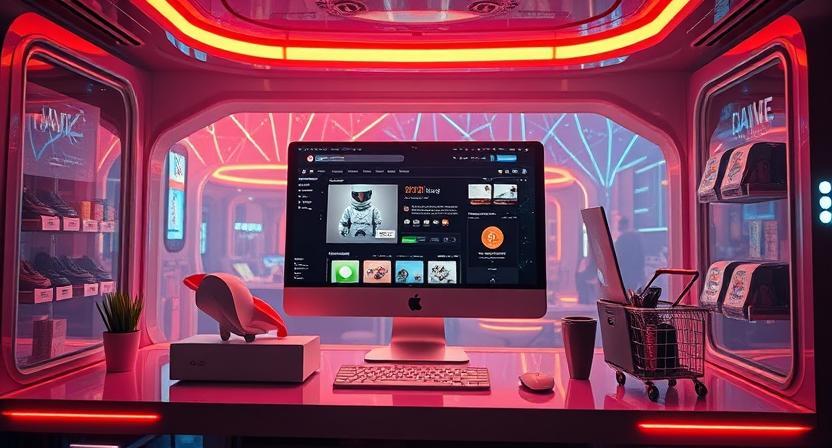
Building a Future-Ready ecommerce Footprint

You know the score. The fierce 2025 e-commerce battlefield, where digital innovation and customer expectations are at an all-time high, 'good enough' isn't just a missed opportunity; it's a liability. In Blog Series Part 1, we exposed the hidden costs of outdated technology, detailed the soaring expectations of customers, and laid bare the competitive fallout of digital stagnation. If you missed it, you can catch up HERE.
Now that we have this understanding in place, it's time to transition from problem to proactive solution. In this article, we'll dive deep into what it truly means to build a future-ready e-commerce footprint. We'll explore the essential pillars of modern digital architecture, uncover how leveraging cloud and AI can transform your operations, and outline strategies for optimizing your customer experience to meet the demanding standards of 2025. By the time you finish reading, you'll have a crystal-clear blueprint for a digital storefront that not only sells but also scales and truly sets you apart from the competition, delivering insights that'll redefine your approach to online success.
The Foundation for Future-Ready E-commerce
This section reveals the core architectural and technological shifts essential for unparalleled flexibility and control, positioning your e-commerce business for sustained leadership.
A modern e-commerce footprint begins with a Scalable and Agile Architecture, primarily through headless commerce
and microservices. Monolithic platforms, with their rigid front-end and back-end coupling, actively limit growth and stifle innovation. Shopify highlights headless benefits for 2025: superior omnichannel experiences, rich personalization, and greater agility. Businesses can adopt specific tools, such as headless content management systems (CMS) (e.g., Contentful), modern front-end frameworks (e.g., React, Vue.js), and e-commerce platforms with robust headless APIs. Rabiloo underscores the value of such custom, modular builds for architectural flexibility.
This agility is complemented by Cloud-Native Infrastructure. The cloud is your dynamic environment for unmatched scalability and reliability. To leverage the cloud effectively for peak times, companies use auto-scaling for dynamic resource adjustment, serverless functions, and Content Delivery Networks (CDNs) for global content distribution. Autumn Fair 2025 emphasizes cloud's flexibility for traffic surges, international expansion, and improved CX. This reduces overhead, freeing capital for growth, ensuring your platform scales with ambition, as Link My Books implicitly points out.
The third pillar is Data-Driven Personalization & AI. Generic experiences are obsolete. AI-powered personalization adapts interactions based on individual user data. To gather and analyze customer data for effective AI personalization, implement: 1) Unified Data Collection into a Customer Data Platform (CDP). 2) Advanced analytics tools for segmentation and key metric tracking (ReConvert). 3) AI/ML algorithms for predictive behavior, personalized recommendations, and dynamic pricing (Lumenalta, NRSplus).
Solidifying these pillars, namely, agile architecture, cloud infrastructure, and intelligent data utilization, transforms your e-commerce storefront into a highly efficient, adaptive, and future-proof engine designed to outperform competitors.
Building Customer Loyalty Through Experience
Having built the robust tech backbone, the next crucial step is to breathe life into your digital storefront through an exceptional customer experience (CX). In 2025, customers aren't just shopping; they are demanding seamless, intuitive, and highly personalized journeys that transcend channels. Failing here means not only losing sales today but squandering future loyalty. Prepare to discover compelling evidence that a superior CX isn't just a nicety, it's the direct pathway to increased conversions, unwavering loyalty, and demonstrable competitive proof.
Omnichannel Seamlessness is paramount. Customers expect a fluid transition across web, mobile, social, and physical touchpoints. Contentful highlights this as a 2025 trend, emphasizing integrated experiences that boost revenue and loyalty.
Mobile-First Everything is non-negotiable; mobile is the primary shopping tool in 2025. Mobile commerce is projected to reach 62% of all e-commerce by 2027 (Feedonomics). Fast loading, intuitive navigation, and thumb-friendly interactions are critical. AceMedia emphasizes that mobile-first design enhances user experience, boosts SEO, and directly impacts conversion rates through frictionless journeys. Wow-How Studio echoes this sentiment, stressing mobile optimization for higher engagement and sales.
Rich, Interactive Content is a powerful differentiator. Customers crave engaging experiences that help them visualize products and make informed decisions. This includes features like augmented reality (AR) virtual try-ons, product configurators, quizzes, and shoppable videos. Americaneagle.com offers compelling examples of how AR boosts satisfaction and reduces returns. The Media Ant also highlights interactive elements, such as quizzes, calculators, and AR filters, as key ideas to increase engagement in 2025.
Finally, ensuring a streamlined checkout and conversion process is vital. Friction at purchase leads to abandonment. Best practices include minimizing steps, offering guest checkout, prominent trust signals, and diverse payment options (e.g., digital wallets, BNPL, per ECORN Agency). Omniconvert reinforces that transparent costs and clear progress indicators reduce cart abandonment. A frictionless, secure, and fast checkout directly translates to higher conversion rates.
Optimizing for modern CX provides tangible proof of your commitment to the consumer, fostering loyalty and converting more browsers into buyers. This strategic focus ensures every interaction delights, drives measurable growth, and fortifies your market position.
Operational Inefficiencies & Need For Automation
While a brilliant storefront delights customers, hidden inefficiencies behind the scenes can cripple performance. Many businesses face a silent yet significant problem: outdated or manual operational processes that create bottlenecks, increase costs, and limit scalability. Without addressing these, even cutting-edge front-end design will struggle, wasting resources and stifling competitive potential.
A future-ready e-commerce footprint demands operational efficiency through automation. Manual inventory, order processing, shipping, customer service, and marketing execution waste significant time and money. Atomix Logistics demonstrates that automating routine tasks drastically reduces operational expenses and frees human resources for strategic growth initiatives. This shift towards automation can bring about a significant reduction in manual work and cost savings, providing a sense of relief and optimism for the future.
The problem of inefficiency manifests critically:
- Manual Inventory Management: Risks of overselling/underselling, leading to lost revenue and frustrated customers.
- Disjointed Order Fulfillment: Causes shipping delays and errors, impacting satisfaction and increasing returns.
- Reactive Customer Service: Drains resources. NRSplus highlights automation and AI-powered chatbots as key 2025 trends for efficient customer interaction.
- Inefficient Marketing Workflows: Manual processes hinder rapid campaign deployment and optimization.
These aren't minor headaches; they are problems that directly impact your scalability and profitability. For an e-commerce business aiming to "stay ahead in competition," the inability to streamline core operations means slower growth, higher costs, and a constant struggle to meet demand. Link My Books implies efficient internal operations are foundational for handling increased volume and achieving rapid growth without chaos. A reliance on inefficient processes directly impedes a "scalable digital strategy."
Without robust automation and optimized back-end processes, even a stunningly modernized digital storefront can be bottlenecked by internal inefficiencies. This continuous drain on resources becomes a critical weakness, undermining your ability to truly compete and innovate in the dynamic 2025 market.
The Pressure to Modernize and Lead
We've laid out the blueprint for a truly future-ready e-commerce storefront: agile architectures, cloud power, intelligent data utilization, optimized CX, and automated operations. These aren't just suggestions; in 2025, they are your core to survival and market leadership. The pressure to embrace this modernization is unyielding, and the consequences of inaction grow daily.
These modern digital storefronts are rapidly becoming the baseline for success. NRSplus highlights that embracing advanced technologies like AI and prioritizing seamless customer journeys are no longer aspirational goals but fundamental trends. If your e-commerce business isn't pursuing these pillars, you're inviting relentless pressure from every angle:
- Competitive Pressure: While your site is "good enough," agile competitors, empowered by modern technology (such as headless commerce and Shopify), are rapidly outmaneuvering you with faster features and superior customer experience.
- Customer Expectation Pressure: The 2025 consumer demands hyper-personalized, instant, and consistent omnichannel experiences (Contentful). Failing to deliver results leads to immediate abandonment and ongoing customer churn.
- Operational Pressure: Internal inefficiencies, unaddressed by automation and integrated systems (Atomix Logistics), will relentlessly squeeze margins, divert human capital, and cripple scalability (Link My Books). This internal friction hinders the ability to respond to market demands.
This mounting pressure is now here, impacting your daily operations and long-term viability. The choice is stark: either your e-commerce blueprint is designed for true competitive advantage and scalable growth, or it's destined to be overwhelmed. Rabiloo implies that modernizing your e-commerce is an active, strategic journey essential for continued relevance.
Your digital storefront is more than just a website; it's a strategic asset in the race for market leadership. Are you prepared to transform it into the powerful engine your ambitions demand?
Blueprint to Unstoppable Growth
You've now seen the blueprint: scalable architecture, cloud, AI-driven data, optimized CX, and automation are the core of modern e-commerce. These pillars, detailed in this article, are no longer optional—they are the foundation for market leadership. The pressure to embrace this modernization is immense, and inaction guarantees you'll fall behind.
As you reflect, ask yourself: Is your business truly equipped to leverage these advancements and bring this blueprint to life? The gap between knowing what to build and mastering how to make it, especially with your team, is where true competitive advantage is won.
The power of technology is undeniable, but its full potential is unleashed only when seamlessly integrated with your people and strategy. How do you empower your teams to utilize these tools, fostering a culture of continuous improvement and evolution?
These vital answers, uncovering the indispensable "human element" of e-commerce dominance and how a top-tier, human-centered digital strategy transforms technology into sustainable growth, await in our next article. Your journey to market leadership continues.





